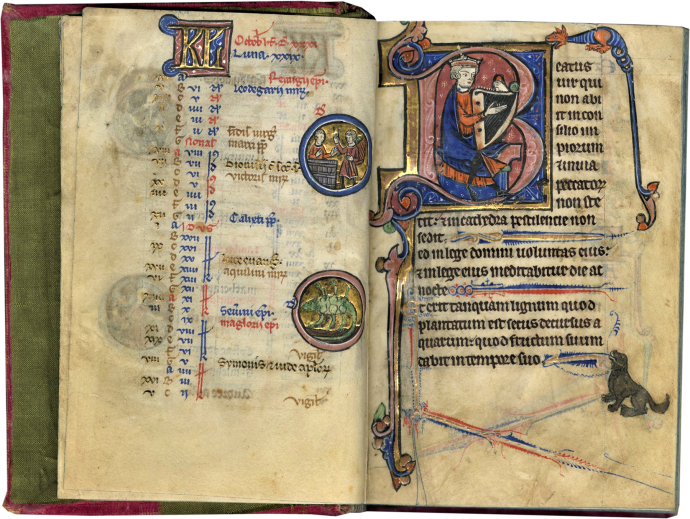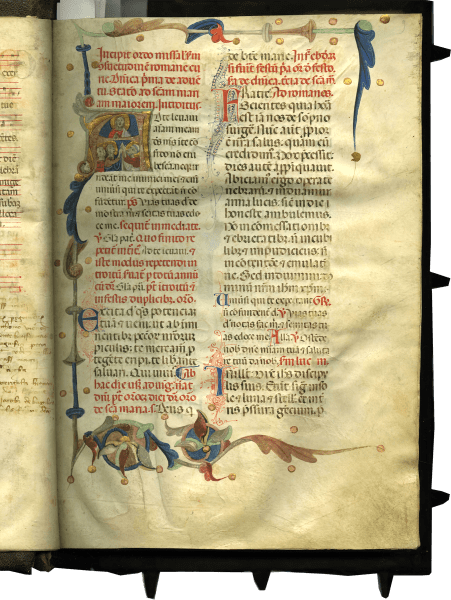








Description
211 folios on parchment, lacking two leaves from the calendar, otherwise apparently complete (collation i6 [-1 and 6, outer bifolium, with loss of text] ii12 iii16 iv-vii18 viii16 ix18 x8 xi12 [beginning f. 147] xii-xv12 xvi6 [-6, cancelled blank]), no catchwords or signatures, ruled in lead with the top two and bottom lines full across, full-length vertical bounding line, (justification 78 x 50-49 mm.), written below the top line in a good gothic bookhand in eighteen long lines by two scribes, with the second scribe beginning on f. 147, each verse begins with one-line alternately polished gold or blue initials with pen decoration in blue or red respectively, red and blue or blue and gold line fillers throughout, some in the form of fish or dragons (for example, ff. 24 and 40v), red and blue, sometimes with gold, pen decoration in the lower margin, often on the diagonal, extending from the bottom pen initial or line filler, often accompanied by penwork dogs, birds, fish, dragons, or other creatures; too many to list but see for example, ff. 5v, 6, 7 (painted), 8 (peacock), 14, 124v (large dragon), animals also appear at the top of initials (for example, 19, painted bird), psalms begin with 2-line pink or blue initials on gold grounds, with foliate infill and extensions into the margins (a few initials are gold on pink and blue grounds), three 4- to 5-line illuminated initials, ff. 66v (Psalm 51), 166v (Psalm 119), and 189, SIXTEEN CALENDAR ROUNDELS depicting zodiac signs and occupations of the months, EIGHT HISTORIATED INITIALS 10- to 8-lines, at the usual divisions of the psalter (described below), some initials with pigment loss (detailed below), trimmed with occasional small loss of decoration at the bottom, stains and minor wear throughout, some openings are quite dirty (e.g. ff. 1-4v, 32v-33, 50v-51), but overall good condition. Bound in old red velvet, flat spine, green silk doublures, blue speckled edges, worn along the joints and edges, doublures creased and fraying, front and back hinges fragile. Dimensions 122 x 84 mm.
A delightful treasure, every page in this small volume sparkles with polished gold. This is in every way a classic example of an illuminated Gothic Psalter from Paris, from the calendar with vignettes of the Labors of the Month and Zodiac and the historiated initials illustrating the major liturgical divisions of the Psalms, to the exuberant penwork line fillers and playful marginal decoration, replete with fish, dogs, dragons, and birds. Once a treasured volume used for private devotion, this manuscript will surely delight any modern owner.
Provenance
1. Written and illuminated in Paris in the second quarter of the thirteenth century as indicated by the saints in the calendar and litany, and the style of the script, illumination, and pen initials. It was illuminated by an artist who also painted a Psalter now in New York, Morgan Library and Museum, MS M.283 (attributed by Robert Branner in the Soissons Atelier, and datable after 1228 and possibly before 1247). The Peter martyr included in the litany in our manuscript is almost certainly the early Roman martyr found in the calendar on June 2, and not the Dominican saint canonized in 1253 (there are no Dominican saints in the calendar or litany).
The evidence of the calendar, although somewhat sparse, points to use in Paris, and includes the following feasts: Germanus, bishop of Paris (May 28); Landericus, bishop of Paris (June 10); Eligius (June 25); Germanus (transitus, July 31); Clodoaldus (Cloud; September 6); and Denis (Dionysisus; October 8, in gold). Also included are feasts that might suggest that this Psalter was made for someone from northern France, including Magloire, bishop of Dol (October 24), Leutfrid, abbot, Evreux (June 21), and Turiavus (Turiaf, bishop of Dol; May 13); however, these saints are amply represented in Parisian calendars; see Calendoscope, Online Resources, and Wieck, 2017, pp. 39-40). Also in the calendar are two saints that are not usually found in Parisian sources: Ranulf, Arras (May 27) and Aquilinus, Evreux (October 19).
The litany, however, does suggest that the original owner of this Psalter may have been from Northern France, and perhaps more particularly, Northwestern France. Included in the litany are Nicasius of Reims, the rare Floscellus (venerated at Coutances, Bayeux, and Autun), Vigor (Bayeux and Arras), Samson (Dol), and Solina (Poitiers and Chartres). Solina, like Floscellus, is an unusual saint. “Sancte Lande” is perhaps St Leu (Landulf) of Evreux.
2. Sold at Bonhams, London, 9 November 2016, lot 151; bought by a private collector.
Text
ff. 1-4v, Calendar, March-October; in red, blue, and brown, with major feasts in sparkling gold;
ff. 5-189, Psalms 1-150 (complete); psalms are copied without rubrics or tituli; Psalm 108 ends near the top of f. 145v; remainder and f. 146rv, are blank; Psalm 109 begins f. 147;
ff. 189-207, Liturgical canticles, hymns and Athanasian Creed: Confitebor (Isaiah 12), Ego dixi (Isaiah 38:10-21), Exultavit (1 Kings 2:1-11), Cantemus (Exodus 15:1-20), Domine audivi (Habakkuk 3), Audite celi (Deut. 32:1-44), Benedicte omnia, Magnificat, Nunc dimittis, Te deum, Benedictus dominus, Quicumque Vult;
ff. 207- 211, Litany including Denis, Maurice, Nicasius, Eustache, Floscellus, and Peter among the martyrs; Germanus, Leonard, Vigor, “Lande,” Samson, Albinus, and Macutus(?) among the confessors, and Genvieve, Columba, Marina, Solina, and Radegundis among the virgins; f. 210v, five prayers (masculine forms); [f. 211v, blank with a few phrases of a prayer added in a clumsy script].
Illustration
The historiated initials in this Psalter are remarkably similar to those in another Psalter, New York, Morgan Library and Museum, MS M.283, attributed by Robert Branner to the Soissons Atelier, and certainly illustrated in Paris, but likely for an English patron, given the evidence of its calendar (Branner, 1977, p. 78, cat. 216, and fig. 181; Online Resources). The Morgan Psalter is datable after 1228 and probably before 1247 (St. Francis is included in the calendar, but Edmund Rich is lacking), and was the only manuscript by these artists known to Branner that was not a Bible. It is now joined by our manuscript. Given the ongoing debate about some of Branner’s attributions, and the question of how his stylistic groupings (somewhat unfortunately dubbed “ateliers”) correspond to the reality of manuscript production in thirteenth-century Paris, the existence of these two manuscripts, which are so closely related, but not identical, is important; a detailed comparison would be rewarding.
Each page of the calendar is illustrated with two roundels depicting the Labors of the Month and the Zodiac; the artist has made one error, switching the zodiac signs for August, which should be Virgo, and September, which is customarily Libra. The scenes are depicted on a background of polished gold, and the calendar itself has entries in brown (some faded), blue, red, and sparkling gold.
f. 1, (March) man pruning vines (or trees); Aries, the ram; (gold in both roundels worn);
f. 1v, (April) man holding a bird’s nest of baby birds and a flower; Taurus, the bull;
f. 2, (May) man on horseback hunting with a falcon; Gemini, the twins; (first roundel with slightly smudged)
f. 2v, (June) man mowing hay with a scythe; Cancer, the crab;
f. 3, (July) man reaping wheat with a sickle; Leo, the lion;
f. 3v, (August) man, naked to the waist, threshing; Libra, a woman holding scales;
f. 4, (September) man sowing seed; Virgo, a young woman holding flowers; (first roundel smudged; both with discoloration to gold background);
f. 4v, (October) a man carrying and another man treading grapes; Scorpio, the scorpion;
Eight historiated initials, 10-lines (f. 5) to 8- lines at the usual liturgical divisions of the Psalter (in addition, there is an illuminated initial at Psalm 51). Initials are white-patterned pink or blue, infilled with pink or blue, on contrasting grounds with polished gold frames, with foliate extensions.
f.5, Psalm 1, King David harping; foliate extensions forming a border in the inner margin, with an animal grotesque forming a border in the top and partially along the outer edge, and a dog at the bottom holding the line filler in its mouth;
f.33, Psalm 26, Anointing of King David, who is depicted crowned (slight pigment loss);
f.50v, Psalm 38. King David pointing to his mouth (slight pigment loss);
f.67v, Psalm 52, the Fool, with bauble and loaf, 8-line blue (some smudging);
f.84v, Psalm 68, King David in the waters, appealing to God;
f.105v, Psalm 80, King David playing a carillon of bells;
f.125, Psalm 97, two priests singing from a choir book on a lectern (faces smudged);
f.147, Psalm 109, the Trinity enthroned.
All 150 Psalms were recited each week during the Divine Office, and the psalms in many Psalters, even those intended for lay use, include prominent initials or miniatures to mark the liturgical divisions. Seven historiated initials mark the psalms said at Matins on each day of the week according to secular use (1, 26, 38, 52, 68, 80, 97); another historiated initial begins psalm 109, the first Psalm at Vespers. The presence of a ninth illuminated initial at Psalm 51 is somewhat less common and reflects the older tradition of dividing the Psalter into three parts.
Psalters were the primary book for private, lay devotion from early in the Middle Ages and well into the thirteenth century (and often much later). In the thirteenth century, as Judith Oliver phrased it, “the medieval Psalter achieved its peak popularity as the devotional book of the laity par excellence” (Oliver, 2005, p. 259). The psalms were the texts devout Christians prayed throughout their life; Psalters were commissioned to mark important occasions, such as marriages, and they were the texts used to teach children how to read.
Literature
Branner, Robert. Manuscript Painting in Paris During the Reign of Saint Louis: a Study of Styles. Berkeley, 1977.
Branner, Robert. “The “Soissons Bible” Paintshop in Thirteenth-Century Paris,” Speculum 44.1 (1969), pp. 13-34.
Büttner, F., ed. The Illuminated Psalter, Studies in the Content, Purpose and Placement of its Images, Turnhout, 2005.
Harper, J. The Forms and Orders of Western Liturgy from the Tenth to the Eighteenth Century: A Historical Introduction and Guide for Students and Musicians, Oxford, 1991.
Leroquais, V. Les Psautiers manuscrits latins des bibliothèques publiques de France, 3 vols, Mâcon, 1940-1941.
Oliver, J. “A Primer of Thirteenth-Century Convent Life: The Psalter as Office and Mass Book,” The Illuminated Psalter, Studies in the Content, Purpose and Placement of its Images, ed. F. Büttner, Turnhout, 2005, pp. 259-270.
Palazzo, Eric. A History of Liturgical Books from the Beginning to the Thirteenth Century, tr. Madeleine Beaumont, Collegeville, Minnesota, 1998.
Plummer, J. Liturgical Manuscripts for the Mass and Divine Office, New York, Pierpont Morgan Library, 1964.
Van Deusen, N., ed. The Place of the Psalms in the Intellectual Culture of the Middle Ages, Albany, 1999.
Wieck, Roger. The Medieval Calendar: Locating Time in the Middle Ages, New York, 2017.
Online Resources
Morgan Library, MS M 283 http://ica.themorgan.org/manuscript/thumbs/77413
D. Muzerelle, “Calendoscope” http://calendoscope.irht.cnrs.fr/accueil
